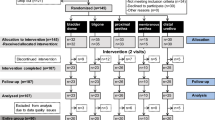Abstract
Background
Somatosensory evoked potentials (SEPs) of the pudendal nerve are a well-established diagnostic tool for the evaluation of pelvic floor disorders. However, the possible influence of sex differences on response latencies has not been established yet. The aim of this study was to standardize the procedures and to evaluate possible effects of gender differences on anal and penile/clitoral SEPs.
Methods
The anal and dorsal penile/clitoral SEPs were recorded in 84 healthy subjects (40 males and 44 females; mean age 47.9 ± 16.6 years, range 16–81 years; mean height 168.3 ± 20.3 cm, range 155–187 cm). Pudendal SEPs were evoked with a bipolar surface electrode stimulating the clitoris or the base of the penis and the anal orifice and recorded using scalp electrodes. The latency of the first positive component (P1) was measured. The effect and possible interaction of (a) stimulation site and (b) gender on the two variables was explored by multivariate analysis of variance (MANOVA).
Results
The examination was well tolerated and a reproducible waveform of sufficient quality was obtained in all the subjects examined. In the female subjects, a mean cortical P1 latency of 37.0 ± 2.6 and 36.4 ± 3.2 ms for anal and clitoral stimulation, respectively, was found. In the male subjects, the cortical latencies were 38.0 ± 3.5 ms for the anal stimulation and 40.2 ± 3.7 ms for the penile stimulation. At MANOVA, a statistically significant main effect of stimulation site and gender as well as a significant interaction between the two variables was found.
Conclusions
Anal and dorsal penile/clitoral SEPs represent a well-tolerated and reproducible method to assess the functional integrity of the sensory pathways in male and female subjects. Obtaining sex-specific reference data, by individual electrophysiological testing, is highly recommended because of significant latency differences between males and females, at least as far as penile/clitoral responses are concerned.

Similar content being viewed by others
References
Vodusek DB, Amarenco G, Podnar S (2009) Clinical neurophysiological tests. In: Abrams P, Cardozo L, Khoury S, Wein A (eds) Incontinence, 4th edn. Health Publications Ltd, Plymouth, pp 523–540
Loening-Baucke V, Read NW, Yamada T, Barker AT (1994) Evaluation of the motor and sensory components of the pudendal nerve. Electroencephalogr Clin Neurophysiol 93:35–41
Podnar S (2003) Electrodiagnosis of the anorectum: a review of techniques and clinical applications. Tech Coloproctol 7:71–76
Haldeman S, Bradley WE, Bhatia NN, Johnson BK (1983) Cortical evoked potentials on stimulation of pudendal nerve in women. Urology 21:590–593
Opsomer RJ, Guerit JM, Wese FX, Van Cangh PJ (1986) Pudendal cortical somatosensory evoked potentials. J Urol 135:1216–1218
Guérit JM, Opsomer RJ (1991) Bit-mapped imaging of somatosensory evoked potentials after stimulation of the posterior tibial nerves and dorsal nerve of the penis/clitoris. Electroencephalogr Clin Neurophysiol 80:228–237
Delodovici ML, Fowler CJ (1995) Clinical value of the pudendal somatosensory evoked potential. Electroencephalogr Clin Neurophysiol 96:509–515
Vodusek DB (1990) Pudendal SEP and bulbocavernosus reflex in women. Electroencephalogr Clin Neurophysiol 77:134–136
Podnar S, Vodusek DB, Trsinar B, Rodi Z (1997) A method of uroneurophysiological investigation in children. Electroencephalogr Clin Neurophysiol 104:389–392
Yang CC, Kromm BG (2004) New techniques in female pudendal somatosensory evoked potential testing. Somatosens Mot Res 21:9–14
Cavalcanti GA, Bruschini H, Manzano GM et al (2007) Pudendal somatosensory evoked potentials in normal women. Int Braz J Urol 33:815–821
Haldeman S, Bradley WE, Bhatia NN, Johnson BK (1982) Pudendal evoked responses. Arch Neurol 39:280–283
Haldeman S, Bradley WE, Bhatia N (1982) Evoked responses from the pudendal nerve. J Urol 128:974–980
Remes-Troche JM, Tantiphlachiva K, Attaluri A et al (2011) A bi-directional assessment of the human brain-anorectal axis. Neurogastroenterol Motil 23:240–248
Jasper HH (1958) The 10–20 electrode system of the International Federation. Electroencephalogr Clin Neurophysiol 10:371–375
Fowler CJ (2001) Neurologist’s clinical and investigative approach to patients with bladder, bowel and sexual dysfunction. In: Fowler CJ, Sakakibara R, Frohman EM, Steward JD (eds) Neurologic bladder, bowel and sexual dysfunction. Elseviers, Amsterdam, pp 1–6
Podnar S, Vodusek DB (2001) Protocol for clinical neurophysiologic examination of the pelvic floor. Neurourol Urodyn 20:669–682
Kaiser T, Jost WH, Osterhage J, Derouet H, Schimrigk K (2001) Penile and perianal pudendal nerve somatosensory evoked potentials in the diagnosis of erectile dysfunction. Int J Impot Res 13:89–92
Campbell WW, Ward LC, Swift TR (1981) Nerve conduction velocity varies inversely with height. Muscle Nerve 4:520–523
Bharucha AE (2006) Pelvic floor: anatomy and function. Neurogastroenterol Motil 18:507–519
Blaivas JG, Labib KL, Bauer SB, Retik AB (1977) A new approach to electromyography of the external urethral sphincter. J Urol 117:773–777
Blaivas JG, Scott RM, Labib KB (1979) Urodynamic evaluation as neurologic test of sacral cord function. Urology 13:682–687
Snooks SJ, Swash M (1984) Abnormalities of the innervation of the urethral striated sphincter musculature in incontinence. Br J Urol 56:401–405
Blaivas JG, Zayed AA, Labib KB (1981) The bulbocavernosus reflex in urology: a prospective study of 299 patients. J Urol 126:197–199
Podnar S (2007) Neurophysiology of the neurogenic lower urinary tract disorders. Clin Neurophysiol 118:1423–1437
Lefaucheur JP (2006) Neurophysiological testing in anorectal disorders. Muscle Nerve 33:324–333
Podnar S, Mrkaić M (2002) Predictive power of motor unit potential parameters in anal sphincter electromyography. Muscle Nerve 26:389–394
Podnar S (2003) Electromyography of the anal sphincter: which muscle to examine? Muscle Nerve 28:377–379
Opsomer RJ, Caramia MD, Zarola F, Pesce F, Rossini PM (1989) Neurophysiological evaluation of central-peripheral sensory and motor pudendal fibres. Electroencephalogr Clin Neurophysiol 74:260–270
Jost WH, Schimrigk K (1994) Magnetic stimulation of the pudendal nerve. Dis Colon Rectum 37:697–699
Pelliccioni G, Scarpino O, Piloni V (1997) Motor evoked potentials recorded from external anal sphincter by cortical and lumbo-sacral magnetic stimulation: normative data. J Neurol Sci 149:69–72
Acknowledgments
The authors are especially indebted to Miss Luana Rosa, technician in neurophysiology, for her technical assistance and skillfulness.
Conflict of interest
None.
Author information
Authors and Affiliations
Corresponding author
Rights and permissions
About this article
Cite this article
Pelliccioni, G., Piloni, V., Sabbatini, D. et al. Sex differences in pudendal somatosensory evoked potentials. Tech Coloproctol 18, 565–569 (2014). https://doi.org/10.1007/s10151-013-1105-9
Received:
Accepted:
Published:
Issue Date:
DOI: https://doi.org/10.1007/s10151-013-1105-9




